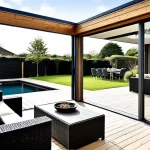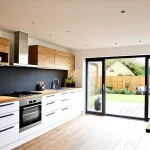Understanding Biophilic Design in UK Homes
Biophilic design centers on reconnecting people with nature by integrating natural elements into living spaces. In UK homes, this design philosophy emphasizes core principles such as natural light, greenery, and organic materials, which work together to create a harmonious environment that nurtures wellbeing.
Key characteristics tailored to UK residential homes typically include the use of native plants suited to the UK climate, maximized daylight through thoughtful window placement, and the incorporation of wood, stone, and other natural finishes that complement traditional and contemporary home styles. These elements ensure that biophilic design suits both older houses and new builds in the UK context.
Also to see : How Can You Create a Seamless Indoor-Outdoor Living Experience in the UK?
Importantly, biophilic design aligns closely with current home design principles driving sustainable, healthy living. UK housing trends increasingly prioritize eco-conscious and wellbeing-enhancing features, supported by government regulations encouraging environmental responsibility and energy-efficient building standards. Incorporating biophilic features into home design not only meets these evolving standards but also promotes a deeper connection to nature, which is especially valuable in urban or suburban UK settings where access to green spaces can be limited.
Enhanced Wellbeing and Mental Health
Recent UK studies consistently highlight that biophilic design significantly enhances wellbeing and mental health within residential spaces. By integrating natural elements such as plants, natural light, and organic textures, biophilic design creates environments that help reduce stress and promote relaxation. This direct connection to nature supports reduced cortisol levels, contributing to lower stress and improved mood for inhabitants.
Have you seen this : What are the best ways to create a minimalist home in the UK?
In practical terms, residents of UK homes that embrace biophilic design report higher overall happiness and increased productivity. The calming influence of greenery, alongside carefully maximized natural light, fosters a sense of peace that benefits both mental clarity and emotional balance. Furthermore, using materials like wood or stone, common in UK home design principles, adds a tactile warmth that supports mental restoration.
Adapting these natural elements to the UK’s unique climate ensures year-round benefits. For example, selecting native or climate-suited indoor plants reduces maintenance while maintaining air quality improvements, an essential aspect for mental health indoors. Thoughtful window placement maximizes daylight even during shorter winter days, sustaining natural circadian rhythms vital to mental wellbeing.
By weaving these components into home design, biophilic principles not only improve mental health but align closely with the UK’s growing focus on holistic, health-conscious living environments.
Increased Property Value and Market Appeal
Biophilic design is increasingly recognized for its positive influence on property value in the UK housing market. Homes that incorporate natural elements such as greenery, natural light, and organic materials tend to attract more interest from buyers who prioritize wellness and sustainability. This rising demand boosts the desirability and resale potential of properties featuring biophilic design principles.
Recent market trends reveal that UK homes with biophilic features can command higher prices. For example, properties with ample natural lighting or well-integrated green spaces often enjoy enhanced curb appeal and a competitive edge. These features align with evolving buyer preferences that emphasize quality of life alongside traditional home characteristics.
Biophilic design also offers versatile home improvement benefits for both new builds and existing residences. Homeowners can incorporate elements such as indoor plants, natural wood finishes, or improved daylight access to upgrade their living environments and increase market appeal. These improvements not only raise property value but contribute to healthier, more enjoyable living spaces.
Integrating biophilic design aligns well with UK home design principles focused on sustainability, wellbeing, and modern living standards. By embracing these principles, property owners position their homes advantageously within market trends, ensuring long-term value and relevance in the competitive UK property market.
Energy Efficiency and Environmental Impact
Biophilic design plays a pivotal role in enhancing energy efficiency within UK homes. By integrating natural lighting, ventilation, and insulation, this approach reduces reliance on artificial heating and cooling systems, lowering overall energy consumption. Maximizing daylight minimizes the need for electric lighting during the day, which in the UK’s often overcast climate requires careful window placement and the use of reflective surfaces to optimize light flow.
Natural ventilation, another core biophilic principle, promotes airflow that helps regulate indoor temperatures without excessive use of mechanical systems. Designing homes to harness prevailing winds and include operable windows can improve air quality and cooling, especially during warmer months, contributing to both comfort and energy savings.
Sustainability is inherent in biophilic design, aligning with UK regulations that encourage eco-friendly homes. Incentives and building codes increasingly demand features like enhanced insulation and energy-efficient glazing, which complement biophilic elements such as wood and stone materials. These materials not only reduce environmental impact but also contribute to thermal mass, balancing indoor temperatures efficiently.
Thus, biophilic design supports eco-friendly homes by combining aesthetic natural elements with practical features that advance sustainability goals within the UK housing sector. Homeowners benefit from lower energy bills and reduced carbon footprints while living in spaces that nurture both environmental responsibility and personal wellbeing.
Popular Biophilic Design Features for UK Residences
Incorporating plants, natural materials, and thoughtfully selected home features is central to successful biophilic design in UK homes. Among the most common elements are indoor plants that improve air quality and add greenery year-round. Popular choices for UK residences include hardy species like ferns, spider plants, and peace lilies, which tolerate varying light levels and the UK’s climate indoors with minimal maintenance.
Green walls or living walls are gaining traction as a stylish, space-saving way to bring nature inside. These vertical plant installations not only enhance visual appeal but also contribute to improved indoor air and humidity regulation. When considering natural finishes, materials such as reclaimed wood, stone, and cork resonate well with home design principles in the UK, blending durability with organic textures that foster wellbeing.
Practical incorporation involves balancing these natural features with the home’s architecture and lighting conditions. For example, placing plants near windows maximizes their growth potential while allowing natural light to brighten interiors. Using timber or stone in flooring, furniture, or accent walls further reinforces a connection to nature and supports sustainable choices aligned with UK building standards.
By carefully selecting suitable plants and natural materials, homeowners create environments that are both aesthetically pleasing and functional. These features support cleaner air, enhanced mood, and sustainable living—all key benefits of biophilic design tailored to the UK’s residential contexts.
Real-Life Examples and Emerging Trends
Emerging UK trends in biophilic design increasingly reflect innovative approaches that blend nature with modern architecture. Recent case studies showcase how homeowners and developers apply biophilic principles creatively to enhance living environments. For instance, some projects feature expansive green roofs and integrated courtyard gardens, which not only provide aesthetic appeal but improve insulation and support energy efficiency.
Research into these innovative designs highlights a growing awareness of how natural materials and spatial arrangements influence wellbeing and environmental impact. UK homes now often incorporate multi-functional green spaces indoors and outdoors, promoting biodiversity and creating microclimates that reduce heating and cooling needs.
Forecasts suggest that regulatory changes will further encourage widespread adoption of biophilic features, emphasizing not just environmental sustainability but also mental health benefits. As a result, new housing developments increasingly integrate advanced ventilation systems combined with abundant natural light access to maximize both comfort and sustainability.
These real-life examples demonstrate the practical application of home design principles rooted in biophilic design. They serve as valuable models for homeowners seeking to balance innovation, wellbeing, and regulatory compliance in the evolving UK residential market.


